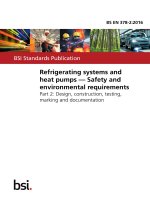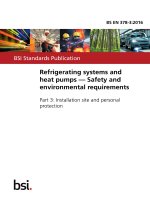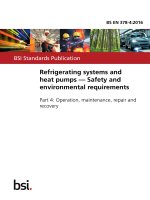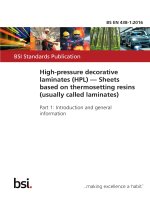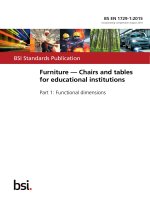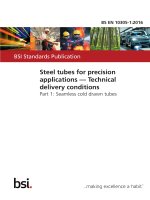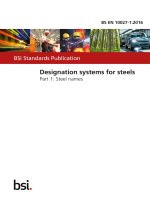Bsi bs en 00378 1 2016
Bạn đang xem bản rút gọn của tài liệu. Xem và tải ngay bản đầy đủ của tài liệu tại đây (2.5 MB, 70 trang )
BS EN 378-1:2016
BSI Standards Publication
Refrigerating systems and
heat pumps — Safety and
environmental requirements
Part 1: Basic requirements, definitions,
classification and selection criteria
BS EN 378-1:2016
BRITISH STANDARD
National foreword
This British Standard is the UK implementation of EN 378-1:2016. It
supersedes BS EN 378-1:2008+A2:2012 which is withdrawn.
The UK participation in its preparation was entrusted to Technical
Committee RHE/18, Refrigeration safety.
A list of organizations represented on this committee can be
obtained on request to its secretary.
This publication does not purport to include all the necessary
provisions of a contract. Users are responsible for its correct
application.
© The British Standards Institution 2016.
Published by BSI Standards Limited 2016
ISBN 978 0 580 84660 1
ICS 01.040.27; 27.080; 27.200
Compliance with a British Standard cannot confer immunity from
legal obligations.
This British Standard was published under the authority of the
Standards Policy and Strategy Committee on 31 December 2016.
Amendments/corrigenda issued since publication
Date
Text affected
BS EN
EN 378-1:2016
378-1:2016
BS
EN 378-1
EUROPEAN STANDARD
NORME EUROPÉENNE
EUROPÄISCHE NORM
November 2016
ICS 01.040.27; 27.080; 27.200
Supersedes EN 378-1:2008+A2:2012
English Version
Refrigerating systems and heat pumps - Safety and
environmental requirements - Part 1: Basic requirements,
definitions, classification and selection criteria
Systèmes frigorifiques et pompes à chaleur - Exigences
de sécurité et d'environnement - Partie 1: Exigences de
base, définitions, classification et critères de choix
This European Standard was approved by CEN on 3 September 2016.
Kälteanlagen und WärmepumpenSicherheitstechnische und umweltrelevante
Anforderungen - Teil 1: Grundlegende Anforderungen,
Begriffe, Klassifikationen und Auswahlkriterien
CEN members are bound to comply with the CEN/CENELEC Internal Regulations which stipulate the conditions for giving this
European Standard the status of a national standard without any alteration. Up-to-date lists and bibliographical references
concerning such national standards may be obtained on application to the CEN-CENELEC Management Centre or to any CEN
member.
This European Standard exists in three official versions (English, French, German). A version in any other language made by
translation under the responsibility of a CEN member into its own language and notified to the CEN-CENELEC Management
Centre has the same status as the official versions.
CEN members are the national standards bodies of Austria, Belgium, Bulgaria, Croatia, Cyprus, Czech Republic, Denmark, Estonia,
Finland, Former Yugoslav Republic of Macedonia, France, Germany, Greece, Hungary, Iceland, Ireland, Italy, Latvia, Lithuania,
Luxembourg, Malta, Netherlands, Norway, Poland, Portugal, Romania, Slovakia, Slovenia, Spain, Sweden, Switzerland, Turkey and
United Kingdom.
EUROPEAN COMMITTEE FOR STANDARDIZATION
COMITÉ EUROPÉEN DE NORMALISATION
EUROPÄISCHES KOMITEE FÜR NORMUNG
CEN-CENELEC Management Centre: Avenue Marnix 17, B-1000 Brussels
© 2016 CEN
All rights of exploitation in any form and by any means reserved
worldwide for CEN national Members.
Ref. No. EN 378-1:2016 E
BS EN
EN 378-1:2016
378-1:2016
BS
EN 378-1:2016
378-1:2016(E)
(E)
EN
Contents
Page
European foreword....................................................................................................................................................... 4
Introduction .................................................................................................................................................................... 6
1
Scope .................................................................................................................................................................... 7
2
Normative references .................................................................................................................................... 7
3
3.1
3.2
3.3
3.4
3.5
3.6
3.7
3.8
Terms and definitions ................................................................................................................................... 8
Refrigerating systems.................................................................................................................................... 8
Occupancies, locations ............................................................................................................................... 10
Pressures......................................................................................................................................................... 11
Components of refrigerating systems................................................................................................... 12
Piping and joints ........................................................................................................................................... 14
Safety accessories ........................................................................................................................................ 15
Fluids ................................................................................................................................................................ 17
Miscellaneous ................................................................................................................................................ 20
4
Symbols and abbreviated terms ............................................................................................................. 20
5
5.1
5.1.1
5.1.2
5.2
5.3
5.4
5.4.1
5.4.2
5.4.3
5.5
5.5.1
5.5.2
5.6
Classification .................................................................................................................................................. 22
Access categories.......................................................................................................................................... 22
General ............................................................................................................................................................. 22
More than one access category................................................................................................................ 23
Designation and classification of refrigerants .................................................................................. 23
Location classification of refrigerating systems ............................................................................... 23
Refrigerating system classification ....................................................................................................... 24
General ............................................................................................................................................................. 24
Direct releasable systems ......................................................................................................................... 24
Indirect systems ........................................................................................................................................... 24
Examples of systems ................................................................................................................................... 24
Direct releasable systems ......................................................................................................................... 24
Indirect systems ........................................................................................................................................... 26
Special requirements for ice rinks......................................................................................................... 29
6
Quantity of refrigerant ............................................................................................................................... 29
7
Space volume calculations ........................................................................................................................ 29
Annex A (informative) Equivalent terms in English, French and German............................................ 30
Annex B (informative) Total equivalent warming impact (TEWI) .......................................................... 34
Annex C (normative) Refrigerant charge limit requirements .................................................................. 37
C.1
Charge limits requirements for refrigerating systems................................................................... 37
C.2
Charge limitations due to flammability for air conditioning systems or heat pumps
for human comfort ....................................................................................................................................... 43
C.2.1 Refrigerant-containing parts in a occupied space ........................................................................... 43
C.2.2 Special requirements for non fixed factory sealed single package air conditioning
systems or heat pumps with a limited charge ................................................................................... 43
C.3
Alternative for risk management of refrigerating systems in occupied spaces .................... 44
C.3.1 General ............................................................................................................................................................. 44
C.3.2 Allowable charge .......................................................................................................................................... 45
2
BS EN
EN 378-1:2016
378-1:2016
BS
EN
EN378-1:2016
378-1:2016 (E)
(E)
Annex D (informative) Protection for people who are inside cold rooms ............................................ 48
D.1
General ............................................................................................................................................................. 48
D.2
Operation of doors and emergency exit doors................................................................................... 48
D.3
Emergency switch or signal ...................................................................................................................... 48
D.4
Cold rooms with a controlled atmosphere .......................................................................................... 49
Annex E (normative) Safety classification and information about refrigerants ................................. 50
Annex F (normative) Special requirements for ice rinks ............................................................................ 61
F.1
Indoor ice rinks ............................................................................................................................................. 61
F.2
Outdoor ice rinks and installations for similar sporting activities ............................................ 61
Annex G (informative) Potential hazards for refrigerating systems....................................................... 62
Annex H (informative) Calculation examples related to C.2 and C.3....................................................... 64
H.1
Example 1 for C.2.1 ....................................................................................................................................... 64
H.2
Example 2 for C.2.1 ....................................................................................................................................... 64
H.3
Example 3 for C.3 .......................................................................................................................................... 64
H.4
Example 4 for C.3 .......................................................................................................................................... 64
Bibliography ................................................................................................................................................................. 66
3
BS EN
EN 378-1:2016
378-1:2016
BS
EN 378-1:2016
378-1:2016(E)
(E)
EN
European foreword
This document (EN 378-1:2016) has been prepared by Technical Committee CEN/TC 182
“Refrigerating systems, safety and environmental requirements”, the secretariat of which is held by DIN.
This European Standard shall be given the status of a national standard, either by publication of an
identical text or by endorsement, at the latest by May 2017, and conflicting national standards shall be
withdrawn at the latest by May 2017.
Attention is drawn to the possibility that some of the elements of this document may be the subject of
patent rights. CEN [and/or CENELEC] shall not be held responsible for identifying any or all such patent
rights.
This document supersedes EN 378-1:2008+A2:2012.
EN 378 consists of the following parts under the general title “Refrigerating systems and heat pumps —
Safety and environmental requirements”:
— Part 1: Basic requirements, definitions, classification and selection criteria;
— Part 2: Design, construction, testing, marking and documentation;
— Part 3: Installation site and personal protection;
— Part 4: Operation, maintenance, repair and recovery.
The main changes in part 1 with respect to the previous edition are listed below:
— harmonization as far as possible with ISO 5149:2014 and ISO 817:2014;
— adapt definitions for the purpose of harmonizing EN 378-2:2016 with PED.
Following detailed changes are worth noting:
— modification of the term “special machinery room” to “separate refrigeration machinery room” and
adapt the definition in view of combustion equipment;
— modifications/inclusion of definitions for “part of the refrigerating system” (3.1.8), “pressure
equipment” (3.1.20) and “pressure vessels” (3.4.8) in view of PED;
— movement of the location classification from Annex C to 5.3;
— rewording of the system examples in 5.3 to make the relation clear with location classification;
— replacement of Annex F (safety group) classifications by 5.2;
— modification of the approach to determine the refrigerant charge of a refrigeration system. The
charge limit requirement is decided based on the most stringent refrigerant charge that results
from the calculation based on toxicity and the calculation based on flammability. To this purpose,
the tables in Annex C are modified. Table C.1 contains requirements based on toxicity classes,
Table C.2 contains requirements based on flammability classes;
4
BS EN
EN 378-1:2016
378-1:2016
BS
EN
EN378-1:2016
378-1:2016 (E)
(E)
— addition of the refrigerant classes as determined in ISO 817 to toxicity classes A, B and flammability
classes 1, 2L, 2, 3;
— modification of the charge limits for refrigerants of flammability class 3, for location classification
III;
— addition of C.3, alternative risk management;
— addition of refrigerants in Annex E that have been approved for publication in ASHRAE 34 in
January 2015 (not those approved for public review in January 2015);
— inclusion in Annex E of GWP values for refrigerants in view of REGULATION (EU) No 517/2014 (Fgas).
According to the CEN/CENELEC Internal Regulations, the national standards organizations of the
following countries are bound to implement this European Standard: Austria, Belgium, Bulgaria,
Croatia, Cyprus, Czech Republic, Denmark, Estonia, Finland, Former Yugoslav Republic of Macedonia,
France, Germany, Greece, Hungary, Iceland, Ireland, Italy, Latvia, Lithuania, Luxembourg, Malta,
Netherlands, Norway, Poland, Portugal, Romania, Slovakia, Slovenia, Spain, Sweden, Switzerland,
Turkey and the United Kingdom.
5
BS EN
EN 378-1:2016
378-1:2016
BS
EN 378-1:2016
378-1:2016(E)
(E)
EN
Introduction
This European Standard relates to safety and environmental requirements in the design, manufacture,
construction, installation, operation, maintenance, repair and disposal of refrigerating systems and
appliances regarding local and global environments. It does not related to the final destruction of the
refrigerants.
It is intended to minimize possible hazards to persons, property and the environment from
refrigerating systems and refrigerants. These hazards are associated with the physical and chemical
characteristics of refrigerants and the pressures and temperatures occurring in refrigeration cycles.
Attention is drawn to hazards such as excessive temperature at compressor discharge, liquid slugging,
erroneous operation and reduction in mechanical strength caused by corrosion, erosion, thermal stress,
liquid hammer or vibration. Corrosion deserves special consideration as conditions peculiar to
refrigerating systems arise due to alternate frosting and defrosting or the covering of equipment by
insulation.
The extent to which hazards are covered is indicated in Annex G. In addition, machinery should comply
as appropriate with EN ISO 12100 for hazards which are not covered by this European Standard.
Commonly used refrigerants except R-717 are heavier than air. Care should be taken to avoid stagnant
pockets of heavy refrigerant vapours by proper location of ventilation inlet and exhaust openings.
Refrigerants and their combinations with oils, water or other substances, can affect the system
chemically and physically. They can, if they have detrimental properties, endanger persons, property
and the environment when escaping from the refrigerating system. Refrigerants shall be selected with
due regard to their potential influence on the global environment (ODP, GWP) as well as their possible
effects on the local environment. Evaluation of the environmental performance requires a life cycle
approach. With regard to global climate change the Total Equivalent Warming Impact approach is
generally used as the basis (see Annex B). Reference should be made to the EN ISO 14040- series to
address other environmental aspects. Many factors influence environmental impacts such as:
— location of the system;
— energy efficiency of the system;
— type of refrigerant;
— service frequency;
— refrigerant leaks;
— sensitivity of charge on efficiency;
— minimization of heat load;
— control methods.
Additional investments may be directed towards reducing leaks, increasing energy efficiency or
modifying the design in order to use a different refrigerant. A life cycle approach is necessary to identify
where additional investments will have the most beneficial effects.
6
BS EN
EN 378-1:2016
378-1:2016
BS
EN
EN378-1:2016
378-1:2016 (E)
(E)
1 Scope
This European Standard specifies the requirements for the safety of persons and property, provides
guidance for the protection of the environment and establishes procedures for the operation,
maintenance and repair of refrigerating systems and the recovery of refrigerants.
The term “refrigerating system” used in this European Standard includes heat pumps.
This part of EN 378 specifies the classification and selection criteria applicable to refrigerating systems.
These classification and selection criteria are used in parts 2, 3 and 4.
This standard applies:
a) to refrigerating systems, stationary or mobile, of all sizes except to vehicle air conditioning systems
covered by a specific product standard e.g. ISO 13043;
b) to secondary cooling or heating systems;
c) to the location of the refrigerating systems;
d) to replaced parts and added components after adoption of this standard if they are not identical in
function and in the capacity;
Systems using refrigerants other than those listed in Annex E of this European Standard are not covered
by this standard.
Annex C specifies how to determine the amount of refrigerant permitted in a given space, which when
exceeded, requires additional protective measures to reduce the risk.
Annex E specifies criteria for safety and environmental considerations of different refrigerants used in
refrigeration and air conditioning.
This standard is not applicable to refrigerating systems and heat pumps which were manufactured
before the date of its publication as a European Standard except for extensions and modifications to the
system which were implemented after publication.
This standard is applicable to new refrigerating systems, extensions or modifications of already existing
systems, and for existing stationary systems, being transferred to and operated on another site.
This standard also applies in the case of the conversion of a system to another refrigerant type, in which
case conformity to the relevant clauses of parts 1 to 4 of the standard shall be assessed.
Product family standards dealing with the safety of refrigerating systems takes precedence over
horizontal and generic standards covering the same subject.
2 Normative references
The following documents, in whole or in part, are normatively referenced in this document and are
indispensable for its application. For dated references, only the edition cited applies. For undated
references, the latest edition of the referenced document (including any amendments) applies.
EN 378-2:2016, Refrigerating systems and heat pumps — Safety and environmental requirements —
Part 2: Design, construction, testing, marking and documentation
EN 378-3:2016, Refrigerating systems and heat pumps — Safety and environmental requirements — Part
3: Installation site and personal protection
EN 12263, Refrigerating systems and heat pumps — Safety switching devices for limiting the pressure —
Requirements and tests
7
BS EN
EN 378-1:2016
378-1:2016
BS
EN 378-1:2016
378-1:2016(E)
(E)
EN
EN 14276-2, Pressure equipment for refrigerating systems and heat pumps — Part 2: Piping — General
requirements
ISO 817:2014, Refrigerants — Designation and safety classification
3 Terms and definitions
For the purposes of this document, the following terms and definitions apply.
NOTE
See informative Annex A for equivalent terms in English, French and German.
3.1 Refrigerating systems
3.1.1
refrigerating system
heat pump
combination of interconnected refrigerant-containing parts constituting one closed circuit in which the
refrigerant is circulated for the purpose of extracting and delivering heat (i.e. cooling and heating)
3.1.2
self-contained system
complete factory-made refrigerating system in a suitable frame and/or enclosure, that is fabricated and
transported complete, or in two or more sections and in which no refrigerant-containing parts are
connected on site other than by isolation valves, such as companion valves
3.1.3
unit system
self-contained system that has been assembled, filled ready for use and tested prior to its installation
and is installed without the need for connecting any refrigerant-containing parts
Note 1 to entry:
A unit system can include factory assembled companion valves.
3.1.4
limit charged system
refrigerating system in which the internal volume and total refrigerant charge are such that, with the
system idle, the allowable pressure will not be exceeded when complete evaporation of the refrigerant
occurs
3.1.5
sorption system
refrigerating system in which refrigeration is effected by evaporation of a refrigerant, the vapour then
being absorbed or adsorbed by an absorbent or adsorbent medium respectively, from which it is
subsequently expelled at a higher partial vapour pressure by heating and then liquefied by cooling
3.1.6
secondary cooling or heating system
system employing a fluid which transfers heat from the product or spaces to be cooled or heated or
from another cooling or heating system to the refrigerating system without compression and expansion
of the fluid
8
BS EN
EN 378-1:2016
378-1:2016
BS
EN
EN378-1:2016
378-1:2016 (E)
(E)
3.1.7
sealed system
refrigerating system in which all refrigerant containing parts are made tight by welding, brazing or a
similar permanent connection which may include capped valves and capped service ports that allow
proper repair or disposal and which have a tested leakage rate of less than 3 grams per year under a
pressure of at least a quarter of the maximum allowable pressure
Note 1 to entry: Joints based on mechanical forces which are prevented from improper use by the need of a
special tool (e.g. by glue) are considered as a similar permanent connection.
Note 2 to entry:
Hermetically sealed systems in EN 16084 are equivalent to sealed systems in EN 378–2.
Note 1 to entry:
The definitions 3.1.9 and 3.1.10 describe the most common situation.
3.1.8
part of the refrigerating system
several components assembled together and exposed to the same pressure in operation or pressure
source, respectively, as determined by the manufacturer
3.1.9
high pressure side
part of a refrigerating system operating at approximately the condenser or gas cooler pressure
3.1.10
low pressure side
part of a refrigerating system operating at approximately the evaporator pressure
3.1.11
mobile system
refrigerating system which is usually in transit during operation
Note 1 to entry: Mobile systems includes refrigerated cargo systems in ships, refrigerating systems in fishing
boats, air conditioning on board, and transport of refrigerated cargo by road, train and containers.
3.1.12
cascade system
two or more independent refrigeration circuits where the condenser of one circuit rejects heat directly
to the evaporator of another
3.1.13
transcritical system
refrigerating system where the compressor discharges refrigerant at a pressure above the critical point
3.1.14
assembly
several components assembled to constitute an integrated and functional whole
Note 1 to entry:
Assemblies are often connected together on-site to make a complete refrigerating system.
3.1.15
component
individual functional item of a refrigerating system
9
BS EN
EN 378-1:2016
378-1:2016
BS
EN 378-1:2016
378-1:2016(E)
(E)
EN
3.1.16
split system
refrigerating system, air conditioner or heat pump incorporating one or more refrigerant circuits,
comprising one or more factory-built indoor units providing cooling or heating to the space and one or
more factory-built outdoor units
3.1.17
multisplit system
split system with more than one indoor unit
3.1.18
indoor unit
part of the split system that controls the temperature of the air inside the building or substances located
in the building
3.1.19
fixed appliance
appliance that is intended to be used while fastened to a support or while secured in a specific location
3.1.20
pressure equipment
components of the refrigerating system, classified as pressure vessels according to definition 3.4.8,
piping including its accessories (e.g. valves) according to definition 3.5, and safety accessories according
to definition 3.6
3.2 Occupancies, locations
3.2.1
machinery room
enclosed room or space, with mechanical ventilation, sealed from public areas and not accessible to the
public, which is intended to contain components of the refrigerating system
Note 1 to entry: A machinery room can contain other equipment provided design and its installation
requirements are compatible with the requirements for the safety of the refrigerating system.
3.2.2
separate refrigeration machinery room
machinery room intended to contain only components of the refrigerating system, accessible only to
competent personnel for the purposes of inspection, maintenance and repair
Note 1 to entry: Where the standard refers to the term machinery room, separate refrigeration machinery
rooms are included.
10
BS EN
EN 378-1:2016
378-1:2016
BS
EN
EN378-1:2016
378-1:2016 (E)
(E)
3.2.3
occupied space
space in a building which is bounded by walls, floors and ceilings and which is occupied by persons for a
significant period
Note 1 to entry: Where the spaces around the apparent occupied space are, by construction or design, not air
tight with respect to the occupied space, these may be considered as part of the occupied space. above; e.g. false
ceilings voids, crawl ways, ducts, movable partitions and doors with transfer grilles or undercut doors.
3.2.4
hallway
corridor for the passage of people
3.2.5
exit
opening in the outer wall, with or without a door or gate
3.2.6
exit passageway
passageway immediately in the vicinity of the exit through which people leave the building
3.2.7
cold room
room maintained by a refrigerating system at a temperature lower than ambient temperature
3.2.8
open air
any unenclosed space, possibly but not necessarily roofed
3.2.9
crawl space
space that is in general accessed for maintenance only and where it is not possible to walk or access by
walking
Note 1 to entry:
Usually, the height of crawl spaces is less than 1 m.
3.2.10
ventilated enclosure
enclosure containing the refrigerating system that does not enable air to flow from the enclosure to the
surrounding space and has a ventilation system that produces airflow from the enclosures to the open
air through a ventilation duct
3.3 Pressures
3.3.1
maximum allowable pressure
PS
maximum pressure for which the system or component is designed for, as specified by the
manufacturer
Note 1 to entry:
PS is the limit which should not be exceeded whether the system is working or not.
Note 2 to entry: The Pressure Equipment Directive 2014/68/EU designates the maximum allowable pressure
as the symbol “PS”.
11
BS EN
EN 378-1:2016
378-1:2016
BS
EN 378-1:2016
378-1:2016(E)
(E)
EN
3.4 Components of refrigerating systems
3.4.1
refrigerating installation
assembly of components of a refrigerating system and all the apparatus necessary for its operation
3.4.2
refrigerating equipment
components forming a part of the refrigerating system, e.g. compressor, condenser, generator, absorber,
adsorber, receiver, evaporator, surge drum
3.4.3
compressor
device for mechanically increasing the pressure of a refrigerant vapour
3.4.4
motor-compressor
fixed combination of electrical motor and compressor in one unit
3.4.4.1
hermetic motor-compressor
combination of a compressor and electrical motor, both of which are enclosed in the same housing, with
no external shaft or shaft seals
3.4.4.2
semi-hermetic (accessible hermetic) motor-compressor
combination consisting of a compressor and electrical motor, both of which are enclosed in the same
housing, having removable covers for access, but having no external shaft or shaft seals
3.4.5
open compressor
compressor having a drive shaft penetrating the refrigerant-tight housing
3.4.6
positive displacement compressor
compressor in which compression is obtained by changing the internal volume of the compression
chamber
3.4.7
non-positive displacement compressor
compressor in which compression is obtained without changing the internal volume of the compression
chamber
12
BS EN
EN 378-1:2016
378-1:2016
BS
EN
EN378-1:2016
378-1:2016 (E)
(E)
3.4.8
pressure vessel
any refrigerant-containing component of a refrigerating system other than:
•
•
coils (including their headers) consisting of pipes with air as secondary fluid;
piping and its valves, joints and fittings;
•
control devices;
•
safety valves, fusible plugs, bursting discs;
•
•
pressure switches, gauges, liquid indicators;
equipment comprising casings or machinery where the dimensioning, choice of material and
manufacturing rules are based primarily on requirements for sufficient strength, rigidity and
stability to meet the static and dynamic operational effects or other operational characteristics and
for which pressure is not a significant design factor. Such equipment may include: pumps and
compressors
Note 1 to entry: The semi-hermetic and open type compressors used in refrigerating systems may be
subject to the exclusion article 1.2.j of the Directive 2014/68/EU by referring to the working party group
guidelines WPG 1/11, 1/12 and 2/34. The compressor manufacturer needs to decide on the basis of a case by
case assessment, if the exclusion article 1.2.j of the Directive 2014/68/EU is applicable.
Note 2 to entry:
This definition is aligned to directive 2014/68 EU.
3.4.9
condenser
heat exchanger in which refrigerant vapour is liquefied by removal of heat
3.4.10
gas cooler
heat exchanger in a transcritical system in which supercritical refrigerant is cooled by removal of heat
3.4.11
receiver
vessel permanently connected to a system by inlet and outlet pipes for accumulation of liquid
refrigerant
3.4.12
accumulator
vessel capable of holding liquid refrigerant and permanently connected between the exit of the
evaporator and suction of the compressor
3.4.13
evaporator
heat exchanger in which liquid refrigerant is vaporised by absorbing heat from the substance to be
cooled
3.4.14
coil or grid
component of the refrigerating system constructed from pipes or tubes suitably connected and serving
as a heat exchanger (e.g. evaporator or condenser)
13
BS EN
EN 378-1:2016
378-1:2016
BS
EN 378-1:2016
378-1:2016(E)
(E)
EN
3.4.15
compressor unit
combination of one or more compressors and associated components
3.4.16
condensing unit
combination of one or more compressors, condensers, receivers (when required) and the associated
components
3.4.17
surge drum
vessel containing refrigerant at low pressure and temperature and connected by liquid feed and vapour
return pipes to one or more evaporators
3.4.18
internal net volume
volume calculated from the internal dimensions of a vessel, and excluding the volume of the permanent
internal parts
3.4.19
type approved component
component for which examination is performed on one or more samples of this component in
accordance with a recognized standard for type approval
3.5 Piping and joints
3.5.1
piping
all piping covered in the scope of EN 14276-2 such as pipes or tubes (including hoses, bellows, fittings,
or flexible pipes) for interconnecting the various components of a refrigerating system
3.5.2
joint
connection made between two parts
3.5.3
welded joint
joint obtained by the joining of metal parts in the plastic or molten state
3.5.4
brazed joint
joint obtained by the joining of metal parts with alloys which melt at temperatures higher than 450 °C
but less than the melting temperatures of the joined parts
3.5.5
flanged joint
joint made by bolting together a pair of flanged ends
3.5.6
flared joint
metal-to-metal compression joint in which a conical spread is made on the end of the tube
14
BS EN
EN 378-1:2016
378-1:2016
BS
EN
EN378-1:2016
378-1:2016 (E)
(E)
3.5.7
compression joint
joints which achieve tightness by deforming a compressing ring
3.5.8
taper pipe thread joint
pipe joint with tapered threads that achieves tightness with filling material or deformation of thread
mount
3.5.9
header
pipe or tube component of a refrigerating system to which several other pipes or tubes are connected
3.5.10
shut-off device
device to shut off the flow of the fluid, e.g. refrigerant, brine
3.5.11
companion valves
pairs of mating stop valves, isolating sections of systems and arranged so that these sections may be
joined before opening these valves or separated after closing them
3.5.12
isolating valves
valves which prevent flow in either direction when closed
3.5.13
locked valve
valve sealed or in other ways constrained, so that it can only be operated by a competent person
3.5.14
nominal size
DN
numerical designation of size which is common to all components in a piping system other than
components indicated by outside diameters or by thread size
Note 1 to entry: It is a convenient round number for reference purposes and is only loosely related to
manufacturing dimensions. The nominal size is designated by DN followed by a number.
3.6 Safety accessories
3.6.1
pressure relief device
pressure relief valve or bursting disc device designed to relieve excessive pressure automatically
3.6.2
pressure relief valve
pressure actuated valve held shut by a spring or other means and designed to relieve excessive
pressure automatically by starting to open at a set pressure and re-closing after the pressure has fallen
below the set pressure
3.6.3
bursting disc
disc or foil which bursts at a predetermined differential pressure
15
BS EN
EN 378-1:2016
378-1:2016
BS
EN 378-1:2016
378-1:2016(E)
(E)
EN
3.6.4
fusible plug
device containing a material which melts at a predetermined temperature and thereby relieves the fluid
3.6.5
temperature limiting device
temperature actuated device that is designed to prevent the generation of excessive temperatures
3.6.6
safety switching device for limiting the pressure
pressure actuated device that is designed to stop the operation of the pressure generator
3.6.6.1
pressure limiter
safety switching device for limiting the pressure which automatically resets
Note 1 to entry:
protection.
A pressure limiter is designated PSH for high pressure protection and PSL for low pressure
3.6.6.2
type approved pressure limiter
safety switching device for limiting the pressure that is type approved according to EN 12263 with
automatically reset
Note 1 to entry: A type approved pressure limiter is designated PSH for high pressure protection and PSL for low
pressure protection.
3.6.6.3
type approved pressure cut out
safety switching device for limiting the pressure that is type approved according to EN 12263 which is
reset manually without the aid of a tool
Note 1 to entry: A type approved pressure cut out is designated PZH for high pressure protection and PZL for
low pressure protection.
3.6.6.4
type approved safety pressure cut out
safety switching device for limiting the pressure that is type approved according to EN 12263 which is
reset manually only with the aid of a tool
Note 1 to entry: A type approved safety pressure cut out is designated PZH for high pressure protection and PZL
for low pressure protection.
3.6.7
changeover valve
valve serving two safety devices and so arranged that only one can be made inoperative at any one time
3.6.8
overflow valve
pressure relief valve discharging to a part of the refrigerating system with lower pressure
16
BS EN
EN 378-1:2016
378-1:2016
BS
EN
EN378-1:2016
378-1:2016 (E)
(E)
3.6.9
surge protection device
device which shuts down the compressor after a few surge pulses (e.g. by measuring pressure
differences across the compressor or current input to the drive motor)
3.6.10
liquid level cut out
switching device for limiting the liquid level
3.6.11
self closing valve
valve that closes automatically e.g. by weight or spring force
3.7 Fluids
3.7.1
refrigerant
fluid used for heat transfer in a refrigerating system, which absorbs heat at a low temperature and a low
pressure of the fluid and rejects heat at a higher temperature and a higher pressure usually involving
changes of the state of the fluid
3.7.2
refrigerant type
specific nomenclature designation of a chemical compound or blend of compounds used as a refrigerant
3.7.3
heat-transfer fluid
fluid for the transmission of heat usually without any change in its phase (e.g. brine, water, air) or with
evaporating and condensing at approximately the same pressure
Note 1 to entry: When fluids listed in Annex E are used they need to comply with all requirements of
refrigerants even if they are used as a heat transfer fluid.
3.7.4
toxicity
ability of a fluid to be harmful, or lethal, or to impair a person’s ability to escape due to acute or chronic
exposure by contact, inhalation or ingestion
Note 1 to entry:
Temporary discomfort that does not impair health is not considered to be harmful.
3.7.5
acute-toxicity exposure limit
ATEL
maximum recommended refrigerant concentration determined in accordance with this European
Standard and intended to reduce the risks of acute toxicity hazards to humans in the event of a
refrigerant release
3.7.6
oxygen deprivation limit
ODL
concentration of a refrigerant or other gas that results in insufficient oxygen for normal breathing
17
BS EN
EN 378-1:2016
378-1:2016
BS
EN 378-1:2016
378-1:2016(E)
(E)
EN
3.7.7
flammability
ability of a refrigerant or heat-transfer fluid to propagate a flame from an ignition source
3.7.8
lower flammability limit
LFL
minimum concentration of refrigerant that is capable of propagating a flame within a homogeneous
mixture of refrigerant and air
3.7.9
practical limit
concentration used for simplified calculation to determine the maximum acceptable amount of
refrigerant in an occupied space
Note 1 to entry: RCL is determined by toxicity and flammability tests, but practical limit is derived from RCL or
historically established charge limit.
3.7.10
refrigerant concentration limit
RCL
maximum refrigerant concentration, in air, in accordance with and specified in C.3 of this European
Standard and established to reduce the risks of acute toxicity, asphyxiation, and flammability hazards
Note 1 to entry:
It is used to determine the maximum charge size for that refrigerant in a specific application.
3.7.11
quantity limit with additional ventilation
QLAV
charge density of refrigerant that when exceeded creates an instantaneous dangerous situation, if the
total charge leaked within the occupied space
Note 1 to entry: See C.3 for the use of Quantity Limit with Additional Ventilation (QLAV) to manage risk for
systems in occupied spaces where the level of ventilation is sufficient to disperse the leaked refrigerant within 15
min.
3.7.12
quantity limit with minimum ventilation
QLMV
charge density of refrigerant that would result in a concentration equal to the RCL in a room of non-air
tight construction with a moderately severe refrigerant leak
Note 1 to entry: See C.3 for the use of Quantity Limit with Minimum Ventilation (QLMV) to manage risk for
systems in occupied spaces not below ground level where the level of ventilation is not sufficient to disperse the
leaked refrigerant within 15 min. The calculation is based on an opening of 0,003 2 m2 and a leak rate of 2,78 g/s.
3.7.13
outside air
air from outside the building
18
BS EN
EN 378-1:2016
378-1:2016
BS
EN
EN378-1:2016
378-1:2016 (E)
(E)
3.7.14
halocarbon and hydrocarbon
either:
— CFC: fully-halogenated halocarbon containing only chlorine, fluorine and carbon;
— HCFC: halocarbon containing hydrogen, chlorine, fluorine and carbon;
— HFC: halocarbon containing only hydrogen, fluorine and carbon;
— PFC: fully fluorinated halocarbon containing only fluorine and carbon;
— HC: hydrocarbon containing only hydrogen and carbon
3.7.15
recover
removing refrigerant in any condition from a system and storing it in an external container
3.7.16
recycle
reducing contaminants in used refrigerants by separating oil, removing non-condensables and using
devices such as filters, driers or filter-driers to reduce moisture, acidity and particulate matter
Note 1 to entry:
The aim of recycling is to reuse the recovered refrigerant.
3.7.17
reclaim
processing used refrigerants to new product specifications
Note 1 to entry: Chemical analysis of the refrigerant determines that appropriate specifications are met. The
identification of contaminants and required chemical analysis both are specified in national and international
standards for new product specifications.
3.7.18
disposal
to dispose or to convey a product usually for scrapping or destruction
3.7.19
bubble point
liquid saturation temperature of a refrigerant at a specified pressure at which a liquid refrigerant first
begins to boil
Note 1 to entry:
point.
The bubble point of a zeotropic refrigerant blend, at constant pressure, is lower than the dew
3.7.20
autoignition temperature of a substance
lowest temperature at or above which a chemical can spontaneously combust in a normal atmosphere
without an external source of ignition, such as a flame or spark
3.7.21
response time
time elapsing from the moment a gas detection probe is placed into a concentration or exposed to a
calibration gas or in front of a leak until an alarm is triggered
19
BS EN
EN 378-1:2016
378-1:2016
BS
EN 378-1:2016
378-1:2016(E)
(E)
EN
3.8 Miscellaneous
3.8.1
competence
ability to perform satisfactorily and safely the activities related to a given task
Note 1 to entry:
Levels of competence are defined in EN 13313.
3.8.2
human comfort air conditioning
method of air treatment designed to satisfy the comfort requirements of the occupants
3.8.3
self-contained breathing apparatus
breathing apparatus which has a portable supply of compressed air, independent of the ambient
atmosphere, where exhaust air passes without recirculation
3.8.4
vacuum procedure
procedure to remove gases and moisture from inside a refrigerating system
3.8.5
factory made
manufactured at a dedicated production location under control of a recognised quality system
3.8.6
operator
natural or legal person exercising actual power over the technical functioning of refrigerating systems
3.8.7
refrigerant detector
sensing device which responds to a pre-set concentration of refrigerant gas in the environment
4 Symbols and abbreviated terms
Table 1 — Quantities
Symbol Quantity
αi
A
ATEL
d
Eannual
GWP
GWPi
h
20
Unit
Unit
Symbol
Rate of gas recovered from the insulation at
end of life, from 0 to 1
-
Acute toxicity exposure limit
kg/m3
Area
square metre
Diameter
metres
Energy consumption
Global warming potential, CO2-related
kilogramme per cubic metre
kilowatt-hour per year
-
The global warming potential of gas in the
insulation
Height
metre
m2
m
kWh/year
-
m
BS EN
EN 378-1:2016
378-1:2016
BS
EN
EN378-1:2016
378-1:2016 (E)
(E)
Symbol Quantity
Unit
Unit
Symbol
L
Leakage
kilogramme per year
kg/year
Lower flammability limit
kilogramme per cubic metre
kg/m3
l
LFL
m
mi
mͦ
n
ODL
P
Q
QLAV
QLMV
RCL
s
t
T
TEWI
V
Vͦ
x
α recovery
β
ρ
Length
metres
Refrigerant charge
Gas charge in the insulation system
Leak rate
System operating time
kilogramme
Kilogramme per second
year
Oxygen deprivation limit
kilogramme per cubic metre
Pressure
Pascal
Air flow
Quantity limit with additional ventilation
Quantity limit with minimum ventilation
Refrigerant concentration limit
Time since leak starts
Cubic metres per hour
kilogramme per cubic metre
kilogramme per cubic metre
kilogramme per cubic metre
Seconds per cubic metre
second
hour
year
Time
Temperature
Total equivalent warming impact
Volume
Air flow
Refrigerant concentration in the room
Recovery/recycling factor
CO2-emission
Density of the fluid
kilogramme
degrees centigrade
Kelvin
kilogramme (of CO2)
cubic metre
Cubic metres per second
kilogramme per cubic metre
0 to 1
kilogramme per kilowatt-hour
kilogramme per cubic metre
Table 2 — Constants
Symbol
Description
Value
c
Flow coefficient
1,0 for orifice
mͦ
Leak rate
m
kg
kg
kg/s
year
kg/m3
Pa
m³/h
kg/m3
kg/m3
kg/m3
s/m³
s
h
year
°C
K
kg
m3
m³/s
kg/m3
-
kg/kWh
kg/m³
0,00278 kg/s
21
BS EN
EN 378-1:2016
378-1:2016
BS
EN 378-1:2016
378-1:2016(E)
(E)
EN
Table 3 — Abbreviated terms
Abbreviation Term
DN
GWP
GWPi
ODP
PED
PS
5 Classification
Nominal size
Global warming potential, CO2-related
The global warming potential of gas in the
insulation
Ozone depleting potential
Pressure equipment directive
Maximum allowable pressure
5.1 Access categories
5.1.1 General
Occupancies are categorised with respect to the safety of the persons, who may be directly affected in
the event of abnormal operation of the refrigerating system. Considerations of safety in refrigerating
systems take into account the site, the number of people occupying the site and the access categories.
Machinery rooms (see 3.2.1 and 3.2.2) shall not be considered occupied space except as defined in
EN 378-3:2016, 5.1. The access categories are defined in Table 4.
Table 4 — Access categories
Categories
General characteristics
Examples a
General
access
a
Rooms, parts of buildings, building where
— sleeping facilities are provided
— people are restricted in their movement
— an uncontrolled number of people are
present
— any person has access without being
personally acquainted with the necessary
safety precautions
Hospitals, courts or prisons, theatres,
supermarkets, schools, lecture halls, public
transport termini, hotels, dwellings,
restaurants
Rooms, parts of buildings, buildings where
only authorized persons have access, who
are acquainted with general and special
safety precautions of the establishment and
where manufacturing, processing or storage
of material or products take place
Manufacturing facilities, e.g. for chemicals,
food, beverage, ice, ice-cream, refineries,
cold stores, dairies, abattoirs, non-public
areas in supermarkets
Supervised
access
b
Authorized
access
c
Rooms, parts of buildings, buildings where
only a limited number of people may be
assembled,
some
being
necessarily
acquainted with the general safety
precautions of the establishment
a The list of examples is not exhaustive.
NOTE
22
Business
or
professional
offices,
laboratories,
places
for
general
manufacturing and where people work
Occupancies can be categorised by national requirements.
BS EN
EN 378-1:2016
378-1:2016
BS
EN
EN378-1:2016
378-1:2016 (E)
(E)
5.1.2 More than one access category
Where there is the possibility of more than one access category, the more stringent requirements apply.
If occupied spaces are isolated, e.g. by sealed partitions, floors and ceilings, then the requirements of the
individual access category apply.
NOTE
Attention is drawn to the safety of adjacent premises and occupants in areas adjacent to a refrigerating
system. Refrigerants heavier than air can cause oxygen deficient pockets at low level (see molecular mass in
Annex E).
5.2 Designation and classification of refrigerants
Refrigerants listed in Annex E use the designation and safety class specified in ISO 817. Practical limits
values shall be those assigned in Annex E.
The practical limit for a refrigerant represents the highest concentration level in an occupied space
which will not result in any escape impairing (i.e. acute) effects or create a risk of ignition of the
refrigerant. It is used to determine the maximum charge size for that refrigerant in a specific
application.
For refrigerants including blends that were commercialised by 2003, the practical limits existing at that
time (as set in previous international or national standards) shall be maintained unless, for non
flammable refrigerants, the ATEL/ODL values exceed the practical limit, in which case the ATEL/ODL
values shall be used.
5.3 Location classification of refrigerating systems
There are four classes of location for refrigerating systems. The appropriate location shall be selected in
accordance with this European Standard which takes account of possible hazards.
The four classes of location are:
a) Class IV - Ventilated enclosure
If all refrigerant-containing parts are located in a ventilated enclosure then the requirements for a
class IV location shall apply. The ventilated enclosure shall fulfil the requirements of EN 378-2 and
EN 378-3.
b) Class III – Machinery room or open air
If all refrigerant-containing parts are located in a machinery room or open air then the
requirements for a class III location shall apply. The machinery room shall fulfil the requirements of
EN 378-3.
c) Class II – Compressors in machinery room or open air
If all compressors and pressure vessels are either located in a machinery room or in the open air
then the requirements for a class II location shall apply unless the system complies with the
requirements of class III. Coils and pipework including valves may be located in an occupied space.
d) Class I – Mechanical equipment located within the occupied space
If the refrigerating system or refrigerant-containing parts are located in the occupied space, then
the system is considered to be of class I unless the system complies with the requirements of class
II.
23
